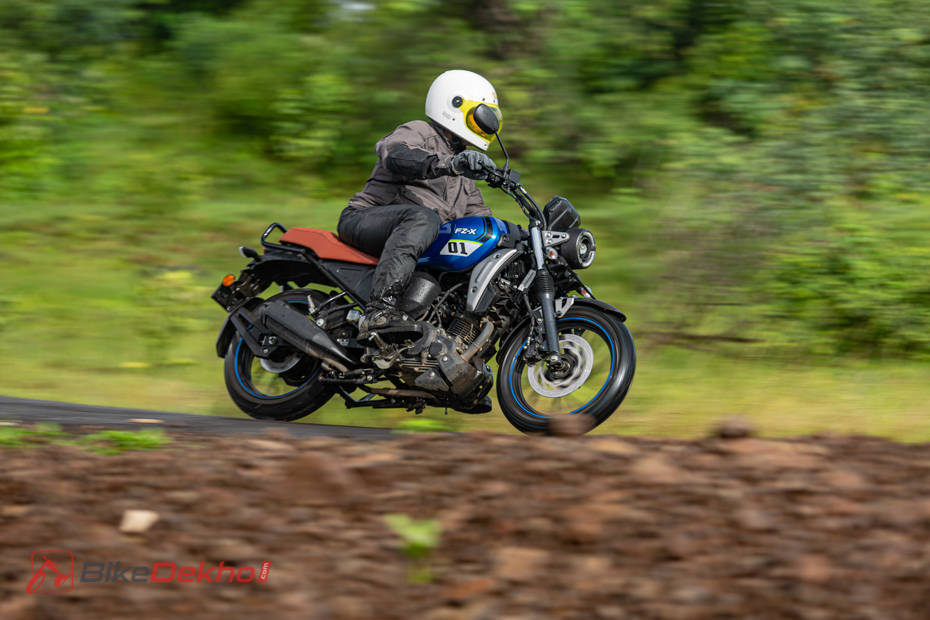Yamaha FZ-X: Road Test Review In Images
Published On Sep 14, 2021 03:31 AM By Manaal Mahatmefor Yamaha FZ X
- 2055 Views
Planning to splurge the extra money over the FZ? Here’s a closer look at Yamaha’s neo-retro machine to help you take a call

Ever since the Yamaha XSR155 made its debut, Indian enthusiasts had been eagerly waiting for the neo-retro bike to grace Indian shores. Instead, the Japanese bikemaker gave us the FZ-X, a bike based on the tried-and-tested formula of the Yamaha FZ-FI.

The Yamaha FZ-X’s styling certainly raises eyebrows, and not for all the right reasons. There’s clearly some influence of the XSR155’s styling, evident from the metal braces, teardrop-shaped tank, and the tuck-and-roll seat. While all the elements individually look great, as a whole they end up making the FZ-X an oddball of the bikemaker’s neo-retro lineup.

The fit and finish of the panels and switchgear is a noticeable step-up from what we have seen from Yamahas a couple of years back.

The Yamaha FZ-X’s digital console is new and packs optional Bluetooth connectivity. With the Yamaha Y-Connect app, you can check the maintenance recommendations, malfunctions and last parking location. However, it lacks turn-by-turn navigation.

The ergonomics of the FZ-X are that of a true-blue commuter. You are perched on a soft saddle, with a tall and wide handlebar weirdly angled towards you, and a bit forward-set footpegs.

While the riding posture is well suited for short city sprints, long hauls are slightly tiring, courtesy the soft saddle and the wide tank. The shape of the tank results in an awkward riding position with your legs spread, requiring you to adjust your feet to shift or use the rear brake.

The 149cc air-cooled single-cylinder engine from the Yamaha FZ-Fi hasn’t been tinkered with. So, one cannot expect enthusiastic performance. Rather, the engine compensates for the lack of performance with its tractability.

Want to ride a gear or two higher? No problem. Want to stick to fifth gear and make your way through traffic? Not a problem. The motor can do speeds as low as 30kmph in the top cog without protest.

The flipside, however, is that highway duties seem a bit out of the league for the Yamaha FZ-X. It runs out of steam pretty quickly and during our acceleration tests, the bike failed to record even 100kmph.

The roll-on acceleration numbers are dismal too. In fact, the bike is slower by 0.6 seconds than the Bajaj Pulsar NS125 in the 0-60kmph runs, and the gap widens to a massive 1.11 seconds in the 0-80kmph run.

The FZ-X is amongst the most fuel-efficient motorcycles in its segment in the city, with a mileage of 55.11kmpl. However, its highway mileage of 48.67kmpl is amongst the lowest in the class. Further adding to its highway woes is the 10-litre fuel tank. Yes, in spite of its bulky appearance, the fuel tank holds three litres less fuel than the FZ-FI, which means you’d require to fuel up more often on the highways.

The FZ-X shares its suspension with the FZ-Fi and the setup is apt for the Indian roads. Not only does it manage to soak in the small bumps, even riding through bigger bumps won’t be a jarring experience.

That said, the suspension is pliant enough so as to not rob you of confidence while cornering. Its cornering ability is limited to an extent by the block-pattern tyres.

The Yamaha FZ-X’s braking capability is decent too. In fact, the neo-retro bike’s braking performance is superior to the 2021 TVS Apache RTR 160 4V. While the FZ’s performance is good, more feedback from the lever would have been appreciated.

The Yamaha FZ-X demands Rs 9,000 over the standard FZ FI and if you opt for the Y-Connect variant of the FZ-X, you’ll have to shell out an additional Rs 5,000. At Rs 1.16 lakh (ex-showroom Delhi), Yamaha has priced the bike at par with the likes of the TVS Apache RTR 160 4V and the Hero XPulse 200, both of which are apt for city as well as highway duties. Unless you are looking for attention, which the FZ-X will definitely get you, you are better off opting for the FZ-FI and saving the money.
